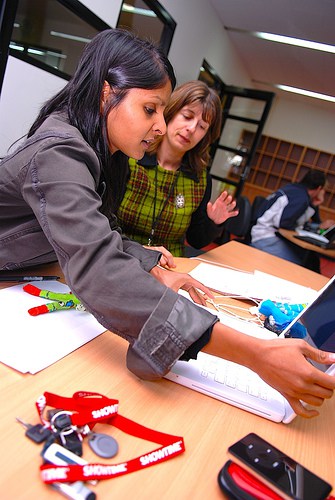Fulton County Schools Launches New Process for Hiring Teachers

Among the 9,000 new teacher applications Fulton County Schools in Atlanta receives each year, the quantity was obvious; the quality of applicants was harder to determine. Now, thanks to Fulton’s new Teacher Selection Model (TSM), the school system has a better way to judge potential teacher effectiveness, through a more rigorous selection process for hiring. The new selection process, which launched in April after a successful whirlwind ramp up to get it in place for 2014-2015 hiring, has already netted the Georgia Association for School Personnel Administrators (GASPA) Best in Class – Platinum Award.
With Fulton’s charter system status and strategic plan in place, ideas were brewing on how to recruit top talent. “With our charter system status we could think differently about who could be teachers, but we still needed to identify the best talent,” said Nathifa Carmichael, talent manager for Fulton County Schools. “Out of 9,000 teacher applications, we select less than ten percent. We had no way to assess whether we had selected the best applicants.” With a grant funded by the Belk Family Foundation (May 2013), Fulton was able to partner with TNTP (The New Teacher Project) to develop a selection model that would be more closely aligned with state teacher evaluation indicators. Carmichael visited Memphis in September 2013, where a similar selection model had been implemented by TNTP which yielded strong results related to predictions of teacher effectiveness. Then Fulton’s new Teacher Selection system launched in April. “We focused early on engaging our end users — applicants, principals, and teachers—in developing the system and making improvements that were relevant to Fulton’s culture and needs. We also ensured that it was clearly aligned with the state of Georgia’s evaluation system. We wanted to foster a culture of innovation by thinking differently to achieve better results. We wanted to reflect the initiatives of the district.”
The new recruitment process puts applicants through a more in-depth pre-screening before they ever land in the pool of candidates for principals’ consideration. TSM is comprised of both central and school-based components. When candidates apply, they pass through the central screening consisting of an application exercise and a short phone interview. These exercises provide a snapshot of candidate potential based on foundational teaching standards. This gives principals quality information to help them identify the highest potential candidates to interview during the school-based component of the selection model. During their interviews, principals can choose from six optional hiring exercises to assess abilities at the school level.
To implement this system, Fulton targeted and recruited a team of 20 top performing teachers to screen and conduct phone interviews with teacher candidates. These teachers were identified by their principals as effective educators who would be strong representatives for the district. Twelve hours of teacher selection training, mock phone interviews, and accuracy assessments prepared these teacher selectors for launch. The selectors operate remotely to process applications and schedule interviews, with the goal of a 72 hour turn-around, processing time with applicants. The teacher selectors are compensated with a supplement, in keeping with Fulton’s approach to reward top performers.
The collaborative nature of TSM’s implementation is at the heart of this story. “Fulton already had a great application processing system in place, but we worked with our system analyst and software developers to leverage it for the Model. We worked closely with departments within the Talent division to make sure we were attending to best practices in recruitment, selection, and retention.” In addition to bringing Talent department leaders to the table, Carmichael assembled a TSM design team that included department representatives from curriculum, special education, professional learning, and teacher quality. “We met with this team of about 15 people once a month. The team would review our progress and offer suggestions. It was wonderful to have them as part of the process, as a way to digest, analyze, and deconstruct elements of the model and its implementation. A reason the project went so well was because of the contributions of the design team. Because we gathered input from so many sources across the district, we were able to get buy-in from district faculty and staff. There’s a collective sense that we’ve done this together,” Carmichael added.
On April 1, the district transitioned to the new application and selection process. Within six weeks, Fulton had over 1000 pre-qualified applicants in the pool. “Our goal is to ensure each student has an effective teacher by identifying those candidates who have greatest potential to increase student growth and achievement,” says Ron Wade, Fulton County’s Chief Talent Officer. “Potential is the critical word — we’re not hiring immediately perfect teachers, we’re keying in on performance that informs likelihood. Our next step is to provide personalized professional development to the new hires. Using TSM data, we can become more targeted in developing teachers through customized programming. We’re not finished by any means, but the system is off the ground and we are already developing new ways to make it better. TSM is not something we’ll put on a shelf: we are constantly revisiting and revising.”





0 Comments
Leave a Comment
Your email address will not be published. All fields are required.